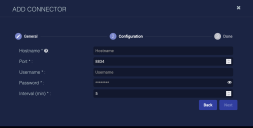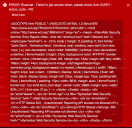Configuring Nessus Connectors
Vulnerability scanners examine hosts for known and possible security vulnerabilities.
Nessus integration with Stellar Cyber enables organizations to conduct vulnerability scans and identify security risks across their network, providing real-time threat intelligence and automated response workflows to improve incident response and threat mitigation.
You can connect Stellar Cyber to your existing vulnerability scanner and have Stellar Cyber generate reports on the target hosts scanned.
See Tenable for information on configuring a Nessus scanner.
Connector Overview: Nessus
Capabilities
-
Collect: Yes
-
Respond: No
-
Native Alerts Mapped: No
-
Runs on: Sensor
-
Interval: Configurable
Collected Data
|
Content Type |
Index |
Locating Records |
|---|---|---|
|
N/A |
Scans |
Domain
N/A
Response Actions
N/A
Third Party Native Alert Integration Details
N/A
Required Credentials
-
Hostname, Username, and Password (of the scanner)
Let us know if you find the above overview useful.
Adding a Nessus Connector
To add a Nessus scanner:
Adding the Connector in Stellar Cyber
To add a new Nessus vulnerability scanner connector in Stellar Cyber:
-
Log in to Stellar Cyber.
-
Click System | Integration | Connectors. The Connector Overview appears.
-
Click Create. The General tab of the Add Connector screen appears. The information on this tab cannot be changed after you add the connector.
The asterisk (*) indicates a required field.
-
Choose Vulnerability Scanner from the Category drop-down.
-
Choose Nessus Scanner from the Type drop-down.
-
For this connector, the supported Function is Collect, which is enabled already.
-
Enter a Name.
This field does not accept multibyte characters.
-
Choose a Tenant Name. The Interflow records created by this connector include this tenant name.
-
Choose the device on which to run the connector.
-
(Optional) When the Function is Collect, you can create Log Filters. For information, see Managing Log Filters.

-
Click Next. The Configuration tab appears.
The asterisk (*) indicates a required field.
-
Enter the Hostname. This is the FQDN or IP address of the scanner.
Do not include https in the Hostname.
-
Enter the Port. The default is 8834.
-
Enter the Username to log in to the scanner.
-
Enter the Password to log in to the scanner.
-
Choose the Interval (min). This is the time between polls of the scanner.
-
Click Next. The final confirmation tab appears.
-
Click Submit.
To pull data, a connector must be added to a Data Analyzer profile if it is running on the Data Processor.
The new connector is immediately active and collects logs for the previous 30 days.
Testing the Connector
When you add (or edit) a connector, we recommend that you run a test to validate the connectivity parameters you entered. (The test validates only the authentication / connectivity; it does not validate data flow).
For connectors running on a sensor, Stellar Cyber recommends that you allow 30-60 seconds for new or modified configuration details to be propagated to the sensor before performing a test.
-
Click System | Integrations | Connectors. The Connector Overview appears.
-
Locate the connector that you added, or modified, or that you want to test.
-
Click Test at the right side of that row. The test runs immediately.
Note that you may run only one test at a time.
Stellar Cyber conducts a basic connectivity test for the connector and reports a success or failure result. A successful test indicates that you entered all of the connector information correctly.
To aid troubleshooting your connector, the dialog remains open until you explicitly close it by using the X button. If the test fails, you can select the button from the same row to review and correct issues.
The connector status is updated every five (5) minutes. A successful test clears the connector status, but if issues persist, the status reverts to failed after a minute.
Repeat the test as needed.
Verifying Ingestion
To verify ingestion:
- Click Investigate | Threat Hunting. The Interflow Search tab appears.
- Change the Indices to Scans. Allow time for the vulnerability scan to complete. The table will then update to show ingested Interflow records.
Data for this connector is not entered into the Scan Index until the scan is in a "Completed" status.








